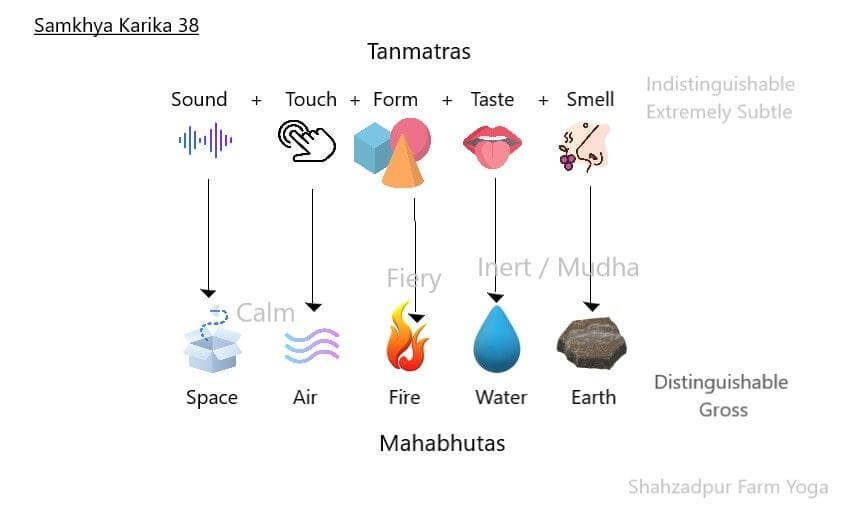Author: Randeep Singh / go to all Samkhya Karikas

Samkhya Karika 38 text:
Tanmaatraanya avisheshah tebhyo bhutaani pancha panchabhyah I
Ete smritaa visheshaah shaantaa ghoraashcha mudaahcha II
Tanmaatraanya – the tanmatras
Avisheshah – indistinguishable
Tebhyo – from them
Bhutaani – five elements, mahabhutas
Pancha – five
Panchabhyah – from these five
Ete – these
Smritaa – remembered
Visheshaah – the distinguishable
Shaantaa – calm
Ghoraash – fearful, intense, strong
Cha – and
Mudaah – dull, inert
Cha – and
Samkhya Karika 38 describes the true nature and place of five Tanmatras within the sequence of the evolution of Prakriti, from the subtlest to the grossest material objects which form the universe.
Nature of Tanmatras – Indistinguishable, can Generate further
Matra is a Sanskrit word which means measure (matra as measure has its own significance in Yoga Pranayama too) and ‘Tan’ mean very subtle. Tanmatras are the five subtle elements, which are so subtle that humans cannot perceive them with their ordinary sense organs.
Science has been able to discern matter up to the level of electron and protons which form the atom, the subtlest basic unit of which matter is made up of. Tanmatras are subtler than that. Tanmatras are the fourth stage of evolution of Prakriti on the Tamasic side of Ahamkara.
Though the Tanmatras (sound, touch, form, taste, smell) are subtle, indistinguishable to human senses, still they have the potency to generate five gross elements (mahabhutas) as individual as well as in various combinations.
As Tanmatras merge with each other grosser forms of basic five elements emerge from them. These elements are very much distinguishable from each other and their characteristics and qualities can be easily perceived by human senses.
Samkhya Karika 38 – Formation and Qualities of Mahabhutas
Tanmatras, or subtle elements combine in different combinations and form the gross five elements or Mahabhutas. For example, Sabda (sound) on its own creates Akasha (space) and when it combines with Sparsh (touch) it generates Vayu (air).
These two elements – Askasha and Vayu exhibit calm (saant) characteristics of Prakriti (nature, material world). Both, Sound and Air need Space to exist in, they need three dimensional element of space to hold them in.
Both Akasha (space) and Vayu (air) are the subtlest from among the five gross elements, or the Mahabutas. Due to their subtle and ethereal construct they exhibit calmness, or tranquility as a characteristic of theirs’s.The more number of Tanmatras combine to form a gross element the. grosser is the element formed and lesser does it exhibit the quality of calmness (saant).
Next, three Tanmatras combine, Rupa (Form) is added to the first two, Sabda and Sparsha, to generate fire as the third gross element. Fire exhibits light and heat which are the main characteristics of this element. This Sankhya Karika text calls these as ‘ghora’ or fiery or dreadful qualities.
Rasa (taste) joins the previous three, Rupa, Sabda, and Sparsha, and give rise to Jala (water). When Gandha (smell) joins the previous four – Rasa, Rupa, Sabda, and Sparsha – Earth element comes into existence.
Water can exhibit mixed qualities or it can inherent different qualities depending on the situation and earth is the grossest of all the five Mahabhutas, which exhibits the qualities of dullness (mudha) and inertness. Earth is heavy and immobile of them all.
Mahabutas are Rembered or can have Mental Imprints
Tanmatras are subtle which are expressed as Mahabutas (gross elements). As per Samkhya Philosophy, as per the principles of evolution of Prakriti, the evolution of the mind, 10 sense organs, Tanmatras and Mahabhutas takes place from Ahamkara (ego) parallel to each other, as evolutes at the same level to each other.
The sense organs present the information of their respective objects (made up of Mahabhutas or 5 gross elements) to the mind which is then rationalized by Buddhi via Ahamkara. Thus, the Qualities, characteristics of the Mahabhutas impact the quality of thoughts of which the mind is composed of.
Secondly, Mahabbhutas are the only evolutes of Prakriti which form the objects of the sense organs and can be read or known by the Buddhi via the mind and Ahamkara. All the evolutes present above the Mahabhutas in the chain of evolution of Prakriti are too subtle to be known or read by the senses and the mind.
Humans cannot sense Tanmatras, Ahamkara, and Buddhi, or Purusha, all present above Mahabhutas int he chain of evolution of the material world. Knowing these evolutes of Prakriti is only possible for some one who has progressed on the path of Yoga and is now capable of knowing the subtlest of the evolutes of Prakriti.
So, the qualities, traits of the material world (Mahabhutas) affect the quality of the thought forms of humans. Moreover, The Mahabhutas can be experienced differently by different people depending upon the quality / bhava the respective Buddhi is in at that moment.
Akasha, or space as an element can be exhilarating for some but some can feel depressed by venturing into open spaces. Every one love their personal space at home, their room for instance, but may feel uncomfortable in the room space of someone else. The bhava Buddhi remains decides the quality of experience one would have from the same object made up of Mahabhutas.
The experience one gets from Mahabhutas is ever changing and cannot be depended upon. Its only when the mind is concentrated with the practice of Yoga Buddhi learns to stay in the Positive (sattvik) bhava for longer which stabilizes the sattvik experience of the objects.
The main point Sankhya Darshan makes is that one must strengthen Buddhi to be able to distinguis between the ever changing material world and strive for experiencing Purusha, the non changing conscious principle.
